Fluorite Mineral: An In-Depth Exploration
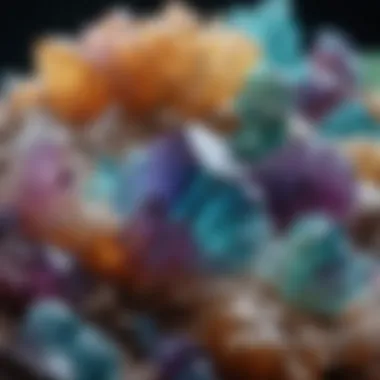
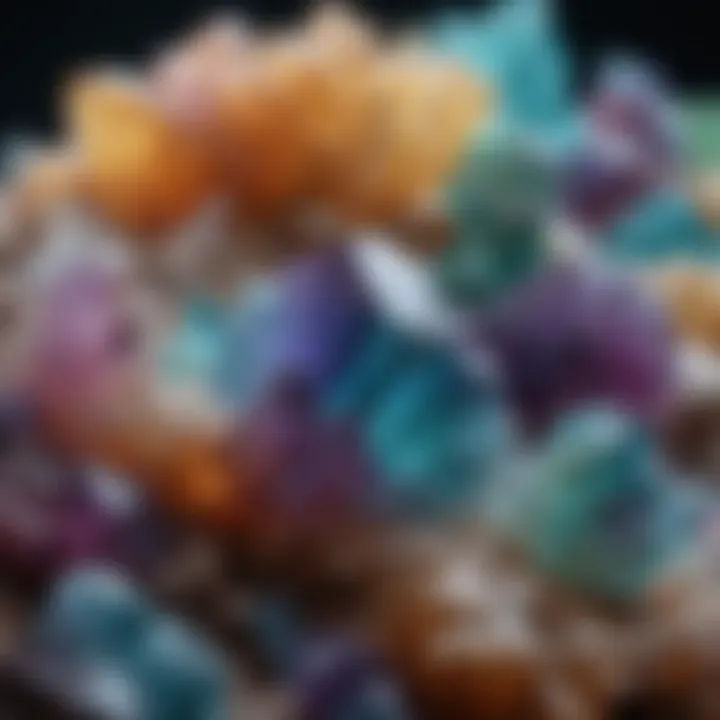
Intro
Fluorite is a mineral that has fascinated collectors and geologists alike for centuries. Known for its vibrant colors and distinct crystal forms, fluorite holds both aesthetic and scientific significance. This exploration intends to provide readers with a detailed understanding of fluorite. It will cover its formation, the environments in which it can be found, and its practical applications in various industries.
In the realm of geology, fluorite plays a significant role in the study of mineral formation processes. Additionally, it is used as a flux in the steelmaking process and is critical in the manufacture of aluminum, glass, and other products.
As we embark on this journey into the world of fluorite, we will also touch on ethical considerations when it comes to collecting this beautiful mineral. The importance of responsible collecting practices will be highlighted to ensure that both enthusiasts and professionals can enjoy and preserve fluorite for future generations.
Stay with us as we delve deeper into the various aspects of fluorite, exploring its unique properties and applications.
Featured Collectible of the Month
Overview
Fluorite is a remarkable mineral that occurs in a range of colors including purple, green, yellow, and clear. These colors are due to the presence of various impurities and the crystal’s unique structure. In terms of crystal form, fluorite typically crystallizes in the cubic system, exhibiting well-defined geometry which makes it appealing to collectors.
Historical Significance
Fluorite has been recognized for its utility since ancient times. The mineral was initially described in the late 18th century when it was used as a flux in metallurgy. The term "fluorite" is derived from the Latin "fluo," meaning "to flow," emphasizing its past significance in metal production. The historical applications of fluorite extend beyond metallurgy, as it was used in early optics as well due to its unique light transmission properties. Merchants often prized high-quality specimens of fluorite for trade, contributing to its historical value.
"Fluorite's historical significance emphasizes its importance in both scientific and industrial contexts."
Understanding the historical context of fluorite enhances its value as a collectible. This context enriches the narrative around each specimen and may impact its desirability among collectors.
Identification Techniques
Visual Characteristics
Identifying fluorite involves noting several key visual traits. Clear fluorite can resemble quartz; however, its cubic cleavage sets it apart. The vibrant colors are often the first point of recognition. Here are some identification tips:
- Cleavage: Fluorite exhibits perfect octahedral cleavage, resulting in smooth surfaces when broken.
- Luster: It possesses a vitreous luster, meaning it has a glass-like appearance.
- Hardness: On the Mohs scale, fluorite ranks around 4, indicating it is softer than many common minerals.
- Fluorescence: Some specimens fluoresce under ultraviolet light, showcasing even more color variations.
Resources for Identification
For collectors seeking to identify fluorite confidently, several resources can aid this process:
- Books on mineral identification: Titles like "Minerals of North America" offer insights into characteristics.
- Online forums: Platforms such as Reddit or Facebook groups focused on mineral collection can provide community support.
- Museum exhibitions: Local geological museums often have mineral displays that can help in recognizing different forms of fluorite.
Preface to Fluorite
Fluorite, often admired for its stunning spectrum of colors and remarkable clarity, holds a significant place in both mineralogy and industry. This section aims to provide a foundational understanding of fluorite, highlighting its role not just as a mineral of aesthetic appeal, but as a compound integral to various industrial applications. For enthusiasts and collectors, understanding the properties and history of fluorite can enhance appreciation and guide better collection practices.
Definition and Composition
Fluorite is a mineral composed mainly of calcium fluoride (CaF2). Its notable feature is its crystalline structure, which can form in various configurations such as cubic, octahedral, and more complex forms. The presence of impurities during its formation contributes to the wide range of colors, including purple, blue, green, yellow, and even colorless variants. This variety not only makes fluorite appealing to collectors but also provides insight into its geological history and the conditions of its formation.
The crystal lattice of fluorite contributes significantly to its optical and physical properties. These include its distinct cleavage, which allows it to break along specific planes, and its relatively low hardness on the Mohs scale, ranking at four. Such properties make fluorite both useful in industrial applications and popular among rock and mineral collectors.
Historical Context
The historical significance of fluorite dates back centuries, with evidence of its use in various cultures for utility and ornamentation. The mineral's name is derived from the Latin word "fluo," meaning "to flow," reflecting its use in metallurgy as a flux to assist in the melting of metals. Over time, fluorite has not only played a role in industry but has also garnered attention in the realms of art and geology.
During the 18th century, scientists began to study fluorite more systematically, leading to its categorization as a distinct mineral by notable figures in geology. The development of more advanced techniques in mineralogy further enhanced the understanding of its unique properties and applications.
Geological Formation of Fluorite
Understanding the geological formation of fluorite is crucial for both collectors and those interested in mineralogy. This section delves into how fluorite forms, the conditions required for its development, and the accompanying minerals that often occur with it. Grasping these concepts enhances appreciation for the mineral and guides effective collecting practices.
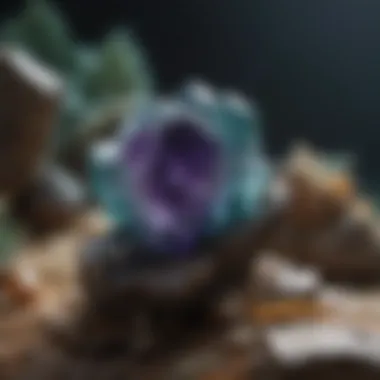

Formation Process
Fluorite, or calcium fluoride, is formed through several geological processes. One primary method is through the process of hydrothermal activity. This occurs when hot, mineral-rich water circulates through the Earth’s crust, permitting the dissolving and recrystallization of minerals. These environments often exist near volcanic areas or along tectonic plate boundaries.
Another aspect involves the cooling of molten rocks. As magma cools and solidifies, various minerals crystallize at different temperatures. Fluorite can form in this context, precipitating from the melt due to changes in temperature and pressure. The formation is influenced by factors like the mineral content of the surrounding rock and the presence of other elements, which can affect the purity and color of the fluorite crystals.
In addition, fluorite may crystallize through sedimentary processes, particularly in areas where there is significant evaporation. In such settings, concentrated solutions can lead to the formation of diverse mineral deposits, including fluorite.
The typical fluorite crystal is noted for its cubic shape, but it can also appear in various forms, reflecting its multifaceted genesis. Both physical and chemical conditions play a significant role in how each crystal grows, resulting in unique specimens.
Associated Minerals
Fluorite seldom appears alone in nature. Its formation is often accompanied by a range of other minerals, which can include:
- Quartz
- Barite
- Calcite
- Pyrite
- Galena
These associate minerals can provide valuable insight into the conditions of formation. For instance, the presence of calcite can indicate particular chemical environments conducive to fluoride formation. Understanding these associations is essential for collectors seeking optimal specimens and helps in identifying potential fluorite-rich deposits.
It is also noteworthy that the color of fluorite can be affected by impurities from these associated minerals, which may introduce different hues. As a result, the interplay between fluorite and its associates adds another layer of complexity and intrigue to the mineral’s character.
"Fluorite is not just a beautiful mineral; it embodies complex geological processes and interactions that reflect the Earth's history."
In summary, the geological formation of fluorite is a multi-layered process involving hydrothermal, igneous, and sedimentary activities. It is enriched by associations with various minerals that enhance its unique properties and appeal. Understanding these factors is not only key to appreciating fluorite's beauty but also vital for effective collection strategies.
Physical Properties of Fluorite
Understanding the physical properties of fluorite is essential for various applications in geology, mineralogy, and industry. These properties not only define the mineral's behavior in natural environments but also underscore its aesthetic and functional characteristics. Knowledge of these features can assist collectors in making informed decisions regarding their specimens and enhance appreciation of the mineral's unique qualities.
Color Variations
Fluorite is known for its stunning color diversity, ranging from transparent and colorless to deep purples, greens, and blues. The variety in colors results from the presence of impurities, radiation exposure, and the crystal structure itself. For instance, the most sought-after shades of fluorite often include deep violet, vivid green, and clear types that showcase their crystal formations beautifully.
- Factors Influencing Color:
- Ionic substitutions: Different ions can enter the fluorite structure, altering its color.
- Natural irradiation: Some specimens can exhibit color shifts due to exposure to natural radiation over time.
Becoming familiar with these variations can aid collectors in recognizing different fluorite types and appreciating their intrinsic value. Moreover, the intense colors of this mineral make it a favorite in jewelry and decorative arts, where visual appeal is paramount.
Crystal Structure
Fluorite crystallizes in the cubic system, which is responsible for its characteristic shapes and forms. Crystals can show a variety of external morphologies, including octahedra and cubes. The crystal structure of fluorite also contributes to its distinct optical properties.
- Significance of Structure:
- The cubic form allows for perfect cleavage in four directions, making it easier to break along the planes.
- This property affects its use in industries where precise shapes are necessary, such as in optical equipment.
Understanding fluorite’s crystal structure not only benefits rock and mineral collectors but also informs industrial applications where specific shapes may be crucial, such as in the production of optical devices.
Hardness and Cleavage
Measuring the hardness of fluorite on the Mohs scale reveals it has a hardness of 4. This means it can be scratched by many common materials but not all. Despite its relatively low hardness, fluorite exhibits perfect octahedral cleavage, which allows it to break cleanly along specific planes. This property can be both an advantage and a limitation during collection and handling.
- Collecting Considerations:
- Handling: Care must be taken when touching or transporting fluorite specimens to avoid chipping or breaking.
- Display: Proper storage is crucial to prevent damage from impacts.
Understanding these properties not only enhances collector awareness but also informs best practices for storage and display, ensuring the longevity and beauty of the specimens.

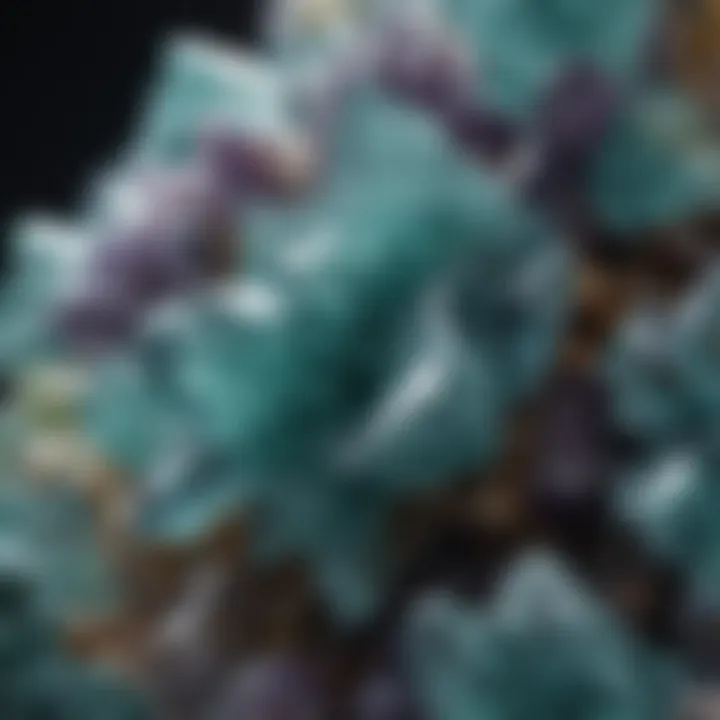
"Fluorite's unique hardness and cleavage properties are crucial to both collectors and industry, defining how this mineral is approached and valued."
In summary, the physical properties of fluorite greatly influence its appeal and functionality. Whether for aesthetic appreciation by collectors or industrial usage, recognizing these aspects aids in a deeper understanding of this remarkable mineral.
Industrial Applications
The industrial applications of fluorite mineral showcase its versatility and significance in various sectors. This section will delve into the critical roles fluorite plays in metallurgy, optical and laser technologies, and the chemical industry. Understanding these applications not only highlights the practical relevance of fluorite but also emphasizes its importance in modern technology and industry.
Use in Metallurgy
Fluorite is often used as a flux in the metallurgical industry. It aids in the removal of impurities from metals during smelting processes. By lowering the melting point of the raw materials, fluorite makes the process more energy-efficient. This property helps in producing cleaner metals with improved qualities.
- Enhancement of Product Quality: By binding with impurities, fluorite allows for easier extraction and results in higher purity levels of metals.
- Cost Reduction: The use of fluorspar as a flux reduces energy consumption, leading to cost-effective metallurgical operations.
- Wide Application: It is commonly utilized in the production of iron, steel, and non-ferrous metals.
Optical and Laser Technologies
Fluorite's unique optical properties make it an essential material in optical and laser technologies. Its low dispersion combined with excellent light transmission qualities sets it apart from other materials. This section will explore how its exceptional characteristics make it indispensable for various applications.
- Lenses and Prisms: Fluorite crystals are used in high-quality lenses for cameras, telescopes, and microscopes. Their ability to minimize chromatic aberration leads to clearer images.
- Laser Systems: In laser applications, fluorite serves as a key component in certain laser designs, enhancing performance.
- UV and IR Applications: Its transparency to UV and infrared light opens a range of uses in scientific and engineering applications.
"The distinct optical properties of fluorite enhance both the precision and clarity of optical equipment, making it a preferred choice among professionals."
Chemical Industry
Fluorite’s contribution to the chemical industry is significant. It acts as a raw material for various chemical processes and compounds. The primary use of fluorite in this industry lies in the production of hydrofluoric acid.
- Hydrofluoric Acid Production: This acid is crucial for producing fluorine-containing compounds, essential for various applications including refrigerants and pharmaceuticals.
- Etching and Cleaning: The chemical industry utilizes hydrofluoric acid for etching glass and as a cleaning agent for metals and other materials.
- Other Applications: Fluorite is also used in the manufacture of aluminum fluoride which is important in the production of aluminum.
In summary, fluorite's ability to act as a precursor in chemical processes makes it vital for the production of many essential compounds, reaffirming its importance across various industries.
Fluorite in Collecting
Fluorite is a sought-after mineral among collectors due to its unique properties and aesthetic appeal. The vibrant colors, ranging from deep green to bright purple, alongside its distinctive crystal forms, make it a valuable addition to many collections. Understanding the nuances of collecting this mineral enhances the experience and protects the future availability of fluorite specimens.
Identifying Fluorite Samples
Identifying genuine fluorite samples involves a keen eye and some basic knowledge of its characteristics. Fluorite typically displays a cubic crystal structure, which can sometimes be mistaken for quartz. Its most striking feature is its color. Fluorite can come in a variety of hues due to impurities, such as iron, cobalt, or organic compounds. Collectors should look for the following attributes:
- Color: Examine the depth and variation of color in the crystal.
- Crystal Habit: Observe the cube shape that defines fluorite, alongside its potential octahedral formations.
- Cleavage: Fluorite has perfect octahedral cleavage, meaning it will break along specific lines when forced.
- Transparency: Note whether the specimen is clear, translucent, or opaque.
Using a basic tool like a pocket knife can help demonstrate cleavage. Understanding these identifiers allows collectors to distinguish between high-quality specimens and less valuable imitations.
Ethical Considerations
Collecting fluorite, like any mineral, raises ethical questions regarding environmental impact and sustainability. Responsible collecting practices are crucial to ensure that natural habitats remain intact. Here are some considerations to keep in mind:
- Source of Collection: Always collect from legitimate mineral shows or shops rather than unauthorized sites.
- Regulatory Compliance: Familiarize yourself with local regulations regarding mineral collection, as illegal collection can harm both the environment and your reputation.
- Educate Others: Share knowledge with fellow collectors about ethical practices to foster a community that values sustainability.
By prioritizing ethical collecting, enthusiasts can help preserve fluorite deposits for future generations while still enjoying the hobby.
Storage and Care
Caring for fluorite specimens is essential for maintaining their beauty and longevity. Fluorite is susceptible to scratches and fades under direct sunlight, thus proper storage is necessary. Here are several practices to ensure the well-being of these prized specimens:
- Avoid Sunlight: Store fluorite away from direct sunlight to prevent color fading.
- Proper Packaging: Use soft cloth or bubble wrap to avoid scratches during storage or transportation.
- Display Considerations: When displaying, opt for a cabinet that protects from dust and impacts.
- Cleaning: Use a soft brush or cloth to clean, and avoid chemical cleaners that can damage the surface.
By implementing these storage and care practices, collectors can enjoy the beauty of fluorite while preserving its integrity for years to come.
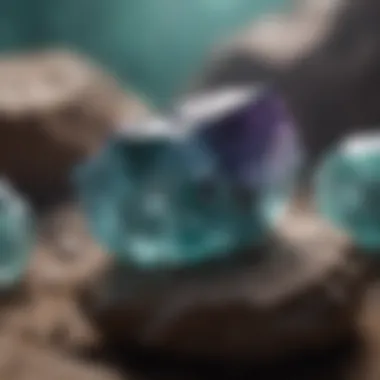
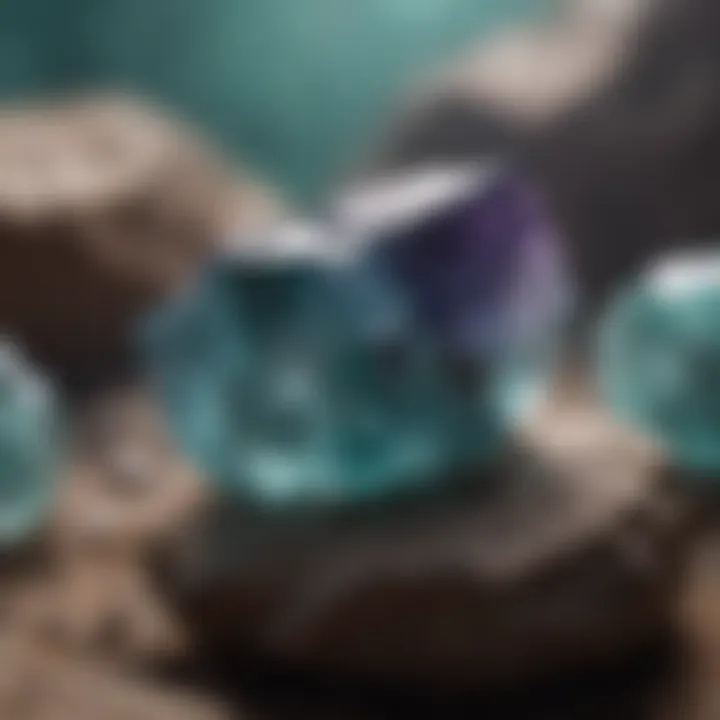
"Collecting should not only be about ownership but also stewardship of the mineral realm."
Fluorite and Culture
Fluorite is not only a mineral valued for its aesthetic and industrial properties but also carries substantial cultural significance. Through history, various civilizations have attributed unique meanings and uses to fluorite. Understanding its cultural importance provides insights into human interaction with natural resources and the symbolic meanings ascribed to them. This section delves into the specific elements that illustrate the relationship between fluorite and culture, highlighting its influence across different domains.
Cultural Significance
In many cultures, minerals, including fluorite, have been associated with healing properties and spiritual attributes. For instance, people in ancient China believed that fluorite could dispel negative energy and enhance mental clarity. This notion persists in modern holistic practices, where fluorite is often used in crystal therapy. Practitioners regard it as a stabilizing stone, aiding in decision-making and emotional balance. The cultural adoption of fluorite reflects a broader trend of using minerals as tools for personal development and well-being.
Moreover, fluorite has played a role in folklore and mythology. In certain cultures, it represents clarity and intellectual prowess, making it a popular choice among scholars and thinkers. Its vibrant colors and striking crystal formation have inspired tales and legends, often linked to themes of enlightenment and insight.
Additionally, fluorite has been a subject of interest in various artisanal crafts and jewelry making. The unique colors and transparency make it an appealing choice for artisans. In contemporary times, collectors often seek out high-quality fluorite specimens to not only display but also to preserve a piece of cultural heritage.
Fluorite in Art
The aesthetic appeal of fluorite extends into the realm of art. Many artists have harnessed the vibrant hues of fluorite in their works, creating pieces that capture the mineral's clarity and depth. From sculptures to decorative objects, fluorite has found its way into various artistic expressions.
In contemporary art, its use has often been symbolic, representing themes such as transformation and clarity of thought. Artists frequently utilize the mineral in mixed media projects, merging it with other materials to create unique visual dialogues. The multi-colored aspects of fluorite, from lush greens to deep purples, offer a palette that inspires creativity.
"Art is not what you see, but what you make others see." - Edgar Degas
Furthermore, exhibitions featuring mineral specimens often draw connections between the scientific study of minerals and artistic representation. These exhibitions not only celebrate the beauty of fluorite but also engage the audience in appreciating the intersection of nature and creativity.
Conservation of Fluorite Deposits
Conserving fluorite deposits serves multiple purposes. Firstly, it safeguards the environmental integrity of mining regions. Damage incurred during extraction can lead to habitat destruction, water pollution, and soil erosion. Therefore, taking steps to protect these deposits can help maintain biodiversity and ecological balance. Secondly, fluorite's economic value is significant. As demand for various industrial applications increases, the sustainability of fluorite mining becomes imperative. Wise management of these resources ensures availability for future generations.
Fluorite, known for its vivid hues and distinct properties, is sought after by collectors and industries alike. The conservation efforts not only focus on preserving these attractive minerals but also on maintaining the geological landscapes where they form. Mining activities can leave lasting scars, disrupting local ecosystems that rely on the mineral's natural habitat. Conservation of fluorite deposits means balancing exploitation with preservation, which is crucial for sustainable development.
Environmental Impacts
Mining and processing fluorite pose various environmental challenges that warrant attention. Some impacts include:
- Habitat Destruction: The removal of flora and alteration of land leads to loss of wildlife habitats.
- Water Pollution: Mineral processing can lead to the leaching of harmful substances into local waterways, affecting aquatic life and drinking water sources.
- Air Quality Degradation: Dust generated during mining activities can cause respiratory issues for nearby communities.
Addressing these environmental impacts requires a comprehensive approach. Sustainable mining practices can minimize damage while allowing for continued extraction of fluorite.
Sustainable Practices
Adopting sustainable practices in fluorite mining involves several strategies:
- Regulated Mining Operations: Strict regulations help manage how and where fluorite is extracted. Guidelines should be in place to ensure minimal disruption to the environment.
- Rehabilitation of Mining Sites: Post-mining rehabilitation includes replanting native species and restoring the land to its natural state.
- Community Engagement: Involving local communities in decision-making fosters a sense of ownership and collective responsibility.
- Research and Innovation: Investing in new technologies can reduce the overall environmental footprint of mining operations.
By implementing these practices, the industry can ensure that fluorite remains a resource available for both collection and industrial use, while also preserving the ecological systems that support it.
"Conservation of mineral resources is essential for ensuring future accessibility and environmental health."
To learn more about the importance of mineral conservation, visit Wikipedia.
Finale
The significance of fluorite mineral, as presented in this article, is multifaceted and extends to various disciplines. Understanding the properties, applications, and cultural contexts of fluorite illuminates its importance beyond a mere collectible.
Recap of Key Insights
Fluorite is notable for its stunning array of colors and unique crystal structures. These characteristics not only draw collectors but also serve industrial purposes, particularly in metallurgy and optical technologies. The mineral's variety in formation and associated minerals adds to its geological significance. Moreover, ethical considerations in collection and conservation practices have emerged as critical themes. Collectors must be aware of the environmental impact of mining and the necessity of sustainable practices. In summary, fluorite stands out as both a beautiful specimen and a valuable resource.
Future of Fluorite Research
Future research into fluorite holds promise in various fields, including geology, materials science, and environmental studies. There is a heightened interest in the unique crystallography of fluorite which may lead to innovative applications in technology and manufacturing. Moreover, as conservation efforts become more paramount, studies related to the sustainability of fluorite mining will gain importance. Researchers might explore methods to minimize ecological footprints while maximizing the extraction of this useful mineral. As both collectors and scientists contribute to understanding fluorite, ongoing discovery will further enhance its relevance in contemporary discussions surrounding minerals and their uses.
"Fluorite is not just a mineral; it is a testament to the intricate processes of nature and a reminder of our responsibility towards sustainable collection practices."
In sum, the exploration of fluorite reveals its vast significance in both scientific inquiry and ethical practices within collecting. The path forward invites further comprehension and deeper engagement with this captivating mineral.



